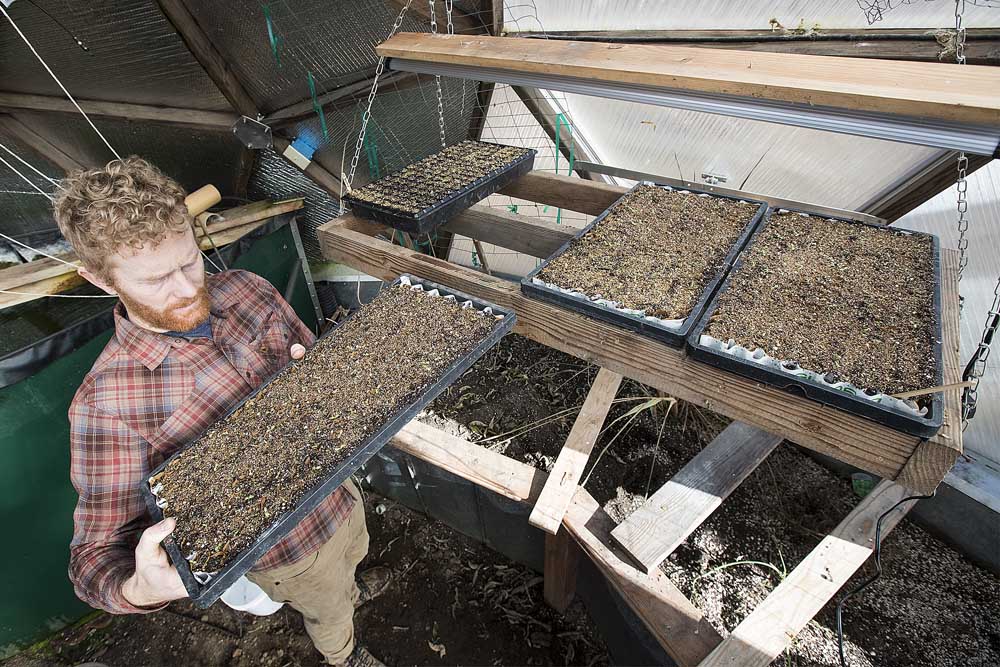Community supported agriculture in Central Oregon changes eating habits
Published 4:00 am Sunday, February 13, 2022

- Benji Nagel checks a tray of seedlings in his greenhouse in Sisters on Sunday.
When Amy Gregory paid for a community supported agriculture membership with Redmond Fibonacci Farms, little did she know the weekly box of fresh vegetables would change her life.
A year later, the former Seattle resident is a vegetarian, eating mainly locally grown vegetables. Her membership gives the farm an infusion of cash before the crop comes up.
Trending
It’s like a timeshare for vegetables. Participants each spring sign up for a CSA, as they’re called, and when the summer harvest begins, they are entitled to a weekly or biweekly box of produce of what ever is harvested at that time.
The farmers in turn get upfront cash that helps cover expenses of soil, fertilizer and seed for spring and summer planting before the crop comes in. Typically, the memberships are about $500 for 20 weekly boxes, or a trip to the farm stand for a supply of fresh produce.
Making a connection between the food consumers eat and a local farmer is not only good for the environment, but also helps support local agriculture, said Annie Nichols, High Desert Food & Farm Alliance agricultural support manager.
“Consumers remove the middle man from their food purchase, which means more money goes into the farmer’s pocket rather than distributors and grocery stores taking a large portion of the producers profits,” Nichols said. “You can also save yourself money.”
Nearly all the money made from farming stays in a community, compared to imported foods, where only 28 cents of every dollar stays in the community, according to a 2017 Economic Impact Assessment of Local Food Producers in Central Oregon report. In 2017, the most recent year data are available, farms employed nearly 30 people and generated $1.5 million in sales on farm operations, according to the economic impact report.
Deschutes County is home to more than 1,400 farms, according to the U.S. Department of Agriculture report.
Trending
“Purchasing a CSA allows farmers to understand their customer demand and plan their crops accordingly,” Nichols said. “By purchasing a CSA you are investing in the success, or failure, of a farm.”
There’s also the connection between the land, the farmer and the consumer who cooks the vegetables and makes a meal, said Gregory. For her that was the big draw.
Each weekly box of vegetables would send her in search of new recipes. When she got an eggplant in her box, she discovered baba ghanoush, a Greek eggplant dish. When vegetable box included kohlrabi, a member of the cabbage family, she discovered how to add it to salads.
“I got to know the people who were growing my food,” Gregory said. “I’m anxiously awaiting the growing season. I always get so much more produce than I can use but then I changed the way I ate.
“It’s all healthy food and last three times as long.”
Lauren Rasmussen is one of the owners at Fibonacci Farms, which grows flowers and vegetables on two farms in Redmond and Bend. She said participants of community supported agriculture help pay the bills and create a relationship with her farms. Typically, her customers are 35 to 55 years old, want to support local agriculture and generally are not bargain shoppers.
“They’re supporting a better environment,” Rasmussen said. “People who buy our CSA produce understand why it’s important to support us. We only sell to the community. Small farms don’t swell outside the community. We need the community to support us because they’re our customers.”
Central Oregon isn’t the easiest area to farm. Weather often is the big unknown and land is expensive. During the winter, it’s hard to gain capital for these small scale farms that produce harvest on the backs of labor, not machinery, Rasmussen said.
“To have a longer than three month growing season, you need frost cloth and greenhouses,” she said. “That costs a lot of money. It’s hard to be a farmer in the high desert. There’s a lot of weather, hail, frost, wind and drought. “
This year she hopes to grow her membership for flowers and vegetables to 100. Last she the two-year-old farm had 15 members.
Like Rasmussen, Benji Nagel, owner of Mahonia Gardens in Sisters, is hoping to expand his membership. Nagel, however, does his membership a bit differently. Rather than asking members to come to the farm for a pre-sorted box of vegetables, Nagel has a farm stand and issues credit for members to select what they want.
Farm stand community supported agriculture prices range from $250 to $750, Nagel said.
“We’re not doing the traditional farm boxes anymore,” Nagel said. “Members will come to our farm stand anytime and pick any produce. We’re bringing in eggs, honey, flowers and berries — items we don’t grow.”
Nagel said he only brings in produce from farms he knows who also are small regional farmers. Mostly he needs to supplement his harvests from his one-acre farm.
“We have been working to figure out what are our most popular items and adjusting our crop plan for the stand,” he said. “Bringing in other items allows us to expand our offerings from other small farms.”
The High Desert Food and Farm Alliance, in collaboration with the Pacific Northwest Community Supported Agriculture Coalition, will host a Central Oregon CSA Share Fair event 6 to 7 p.m. Feb. 22 via Zoom. The hour-long session will be a meet and greet with local farmers and ranchers and give potential members a chance to learn about community supported agriculture memberships. For more information or to RSVP go to https://www.pnwcsa.org/event-details/central-oregon-csa-share-fair.







